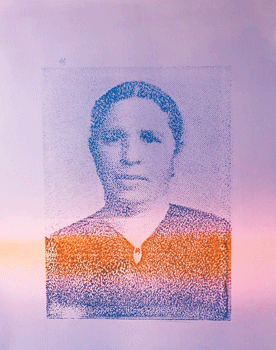 The new exhibit at Gallery 208, “Monument to Strangers: Photographs of Johanna Warwick”, opens Feb. 2 5:30 p.m. Visitors to the exhibition will see a body of work by an artist who utilizes a minimalist approach to comment on cultural history and how obsolete processes can inform and continue to shape perceptions about Americana.
The new exhibit at Gallery 208, “Monument to Strangers: Photographs of Johanna Warwick”, opens Feb. 2 5:30 p.m. Visitors to the exhibition will see a body of work by an artist who utilizes a minimalist approach to comment on cultural history and how obsolete processes can inform and continue to shape perceptions about Americana.
British born but raised in Canada, Warwick works and lives in Baton Rouge, Louisiana. “Monument to Strangers” is the result of Warwick researching and recontextualized daily printed newspapers photographs from the 1880s to the 1960s. Visitors to the gallery will see large scale portraits which have been “recontextualized” to reveal Warwick’s truth, “images affect our understanding of cultural history.”
“Monuments to Strangers” also includes smaller works inspired by the process of image making during an early period in the history of commercial photography and printing. Warwick noted, “it was the first time in history, images of reality could be reproduced on presses reaching the public, rather than an image interpreted and altered by hand.”
We are fortunate in the area to be able to see works by a contemporary photographer who does not live in our region and an artist whose approach is conceptual. As with many conceptual works of art, visitors do not need to know the artist’s intent, but knowing the intent most often enhances a different type of experience than not knowing the meaning or purpose of the work. (For that reason, Gallery 208 always posts artist’s statements throughout the exhibit.)
A prelude to visiting the gallery is best said by Warwick: “In this work, I utilize news images and materially re-contextualize them to emphasize the limitations of photography as an emotionally and factually accurate record of the time. I combine analogue and digital processes to underscore the ways in which news photographs have been produced and how that production affects our understanding of cultural history. The photographs look at the selective representation of the individual within printed daily newspapers from the 1880s to the 1960s.”
Seeing the overly large portraits, 24” x 36,” viewers should be aware Warwick has been inspired by anonymity and through this body of work wanted to “ highlight how women and minorities were vastly underrepresented.” In creating this body of work the artist is “re-presenting these images in hopes to reveal and question our flawed history. The figures in the blocks are unknown, but they were at one point important, or significant enough, to have their image produced in this way. The images reveal how versions of history were presented publicly… I don’t seek to make a document as they were used before, but to photograph them as visual monuments. During this period in history, Men are photographed abundantly; women are few and far between.”
The exhibit also includes exquisite traditional still-lifes, created by using the outdated blocks of commercial printing as a subject. In these small works the artist is showing us an antiquated process while using new technology. Warwick noted:
“I am photographing them to present this historic process and lost imagery in a new way, using the technologies that made them obsolete. In re-photographing these images, my photographs are several iterations of light sensitive materials being exposed: the original photograph, the rephotographed negative, the photomechanical produced block, and my exposure. Each image thus goes from a positive, to a negative, recorded once again as a negative, then inverted to a positive. It is in this long chain of events, which traverses over decades, that the glow of light and color occurs. Together I strive for the photographs to describe the history of representation in American daily newspapers, as well as the history of photography.”
Warwick’s minimalist approach and the medium of photography itself often seems to lend itself to hurrying us hurries through an exhibit, we move too quickly, without contemplation. Due to the elusive nature of photography, the opposite needs to take place. The illusive nature of photography is combining the complexity of a contemporary art in the form of photography with its lingering history, everyone has a camera on their cell phone, and the ever-present hierarchical judgment of photography against other traditional disciplines.
The unfounded hierarchy and the fact the everyone have a camera on their cell phone only strengthens my revered respect for artists, like Warwick, who create remarkable photographic images equal to works of carved marble. The argument against the hierarchy in the arts is based on two facts. The hierarchical position has been outdated for some and each discipline is innately different and brings a particular way of seeing, ideating, and set of skills.
An earlier series by Warwick titled “Between the Ground & Sky” supports the above argument. In this body of Warwick wanted to capture the changing landscape of the Danby Marble Quarry in Dorset Mountain, Vermont. (The Danby Quarry, used since the 18th century, is the largest underground marble quarry in the world.)
She began photographing the marble because she was “curious about its use but eventually became charmed by the physical history carved into the space.” She states: “The heavy unyielding material takes a geometric form inside a huge organic landscape. I am fascinated by the constant metamorphosis of the space . . . Each method of removal has left an indelible impression on the mountain by destroying its natural state and creating a geometric and ordered new landscape. These are the qualities that I find both interesting and intriguing. I am fascinated by its now formal beauty.”
The conceptualization and dexterity by Warwick to create her photographs should not be compared to the idea and carving of figure in stone. Each medium brings is own innate qualities and challenges. If anything, the history of photography is far more interesting than representational figure carving that has been repeated and practiced in western art for centuries. Or, as John Berger, in “Ways of Seeing,” summarizes: “unlike any other visual image, a photograph is not a rendering, an imitation or an interpretation of its subject, but actually a trace of it. No painting or drawing, however naturalist, belongs to its subject in the way that a photograph does.”
Johanna Warwick graduated from Massachusetts College of Art and Design with an MFA in Photography in 2010, and from Ryerson University with a BFA in Photography in 2006. She has been an Assistant Professor of Art & Photography at Louisiana State University since 2015 and exhibited in New York, Toronto and other major cities across North America. She was exhibited in Fresh at Klompching Gallery in Brooklyn, NY, and was a selected artist by Lesley A. Martin as part of her Guest Room curating for Der Greif magazine.
In all types of disciplines art has the potential to bring a truth to the viewer and “Monument to Strangers: Photographs of Johanna Warwick,” meets this criterion. “Monuments to Strangers” opens Feb. 2 at 5:30 p.m. and will remain up until April. The gallery is located at 208 Rowan Street in Fayetteville and is open Monday – Thursday from 9:00 a.m. to 4:00 p.m. For information call 910-484-6200.

 How to resolve AdBlock issue?
How to resolve AdBlock issue? 








